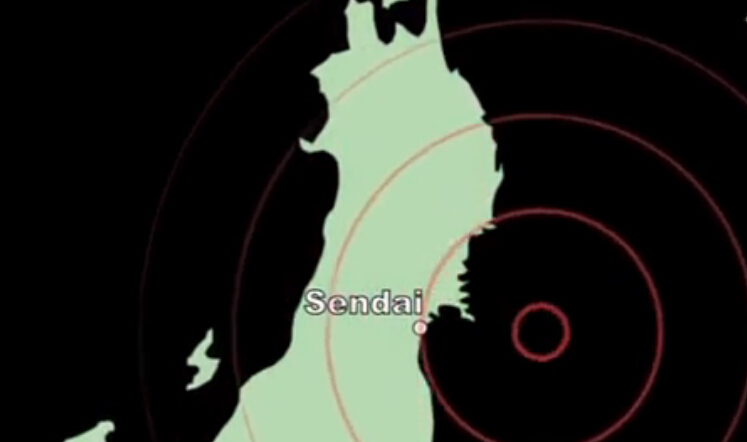Rare Video: Japan Tsunami
勿忘 311 海啸的痛
All across northern Japan, they felt it—a violent, magnitude 9.0 earthquake on March 11, 2011. It was centered about 80 miles offshore, and tsunami warnings went up immediately. In coastal cities, people knew what to do next: run to higher ground.
整个北日本地区,他们感受到它--2011 年 3 月 11 日一阵剧烈、震度 9.0 的地震。震央在近海约 80 里 (约 129 公里) 处,海啸警报立刻发布。在沿海城市,人们知道接下来要做什么:逃到高处。
It's from these vantage points on hills and in tall buildings that incredible footage was captured. In Kesennuma, people retreated to a high-rise rooftop and could only watch in horror as tsunami waves inundated their city, knocking buildings into rubble and mixing into a kind of tsunami soup filled with vehicles, building parts, and contents. Seawater cascaded over seawalls and into cities.
正是从小山上和高耸建物中的这些有利位置,惊人的影片被拍下。在气仙沼市,人们退到高楼屋顶上,但在海啸浪潮淹没他们的城市时只能惊恐地看着,海啸将房屋击碎成瓦砾堆,搅拌成一种混着汽车、房屋零件和内容物的海啸汤。海水滚滚越过防波堤然后进入城市。

This video shows the water rushing over an 18-foot seawall in the Kamaishi city. The seawall here was the world's deepest and largest, but not enough for the magnitude of the March 11 disaster. It was the largest quake ever known in Japan, and one of the five largest recorded in the world. More than 28,000 people are confirmed dead or missing.
这个影片播放出海水冲过一面在釜石市 18 英尺高 (约 5.5 公尺) 的防波堤。这里的防波堤是世界上最深最大的,但不足以应付 3 月 11 号那灾难的强度。这是日本有史以来所知最大的地震,也是全世界记录五个最大的地震之一。超过两万八千人被确认死亡或失踪。
When two tectonic plates push together under the sea, the resulting earthquake sends an enormous burst of energy up through the ocean, displacing enormous quantities of water. With the upward motion, a series of waves expands in all directions.
当两个板块在海底推挤在一起时,产生的地震将一个巨大的能量爆发向上穿透海洋传送出去,排出大量的水。随着那向上的移动,一连串的海浪向四面八方扩散。
In deep water, these waves travel fast—up to 500 miles an hour—but only reach a height of a few feet. A passing ship might not even notice. But as the waves enter shallow waters, friction with the ocean floor lowers the waves' speed, but raises their height.
在深海域,这些海浪移动得很快--高达时速 500 英里 ( 约 805 公里)--但只达到几英尺的高度。一艘经过的船可能甚至不会注意到。但当海浪进入浅海域,和海床的摩擦减慢海浪速度,但提升了海浪的高度。
This video is from a Japan coast guard ship confronting a tsunami wave in shallow water on March 11. And a rare view from the air—video of a tsunami wave approaching the shoreline. In Japan, some tsunami waves reached as far as three miles inland. Japan may be the most seismologically-studied country in the world, and with more than 1,200 high-precision GPS stations, a geophysicist at the University of Alaska used the data to create a visualization of the March 11 quake. The waves of displacement that you see were moving as fast as five miles per second. In this photo, the ripples of tsunami waves are seen moving upstream in the Naka River at Hitachinaka City.
这个影片是来自一艘 3 月 11 日在浅海域遇到一波海啸浪潮的日本海巡船。还有一个空拍的罕见景象--一波海啸浪潮渐渐接近海岸线的影片。在日本,一些海啸浪潮到达内陆三英里 (约 5 公里)的距离。日本可能是全世界地震学上最被研究的国家,有着超过 1,200 个高度精确的 GPS 站点,阿拉斯加大学的一位地球物理学家利用那数据来建立出 3 月 11 日地震的想像图。你所见板块位移产生的波动正达到每秒五英里 (约 8 公里) 的速度在移动。这张相片里,海啸波浪的涟漪在常陆那珂市的那珂川中被观察到正向上游移动。
New technology left an enormous amount of visual evidence for study in years to come, and can, perhaps, help us better understand the power of earthquakes and tsunamis, and prevent loss of life in the future.
新科技留下大量可见证据供未来的研究,且或许可以帮助我们更了解地震和海啸的力量,并在未来避免生命损失。













